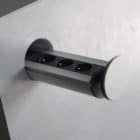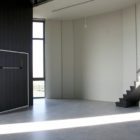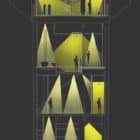Mauro Brigham from Bham Design Studio has designed the Chateau d’Eau project.
Located in Steenokkerzeel, a municipality in the Belgian province of Flemish Brabant, this water tower built in 2038 was converted in a single family six story residence.
Chateau d’Eau project by Mauro Brigham:
The History
“In a small terrain of 16m width by 20m long in the middle of a flat Belgian landscape, raises a 30m high water tower built between 1938 and 1941 for and by the village of Steenokkerzeel. It has been in service until the beginning of the nineties and was used by the Nazis during the 2nd world war as a “tour de guet”.
In 2004 a procedure was filled to protect and preserve the building witch the Royal commission for the protection and preservation of monuments and sites accepted.
The exterior of the tower was fully renovated to its initial state. Damaged concrete columns were repaired and painted, brick joints were completely removed and replaced and the windows in the floor top were enlarged.
The works for a complete renovation and conversion into a single family house started in 2008.
The Program
The program foresees two distinct profiles of users. The private and main user is the client, a couple living at the tower daily. Once or twice a month, part of the building is rented for very exclusive events targeting management people looking for a place to make workshops, high profile companies that seek a unique place to meet top clients near by the airport. Every room is equipped with the latest IT technology, domotics and the possibility to install projectors virtually anywhere on the top floor.
Interior Architecture
The preservation of existing concrete elements such as the main water conduct, concrete ceilings, concrete stairs and the 250.000 liters concrete water basin were essential to preserve the strong identity of the building.
Every visible concrete element inside was painted in dark grey in order to mark the old from the new. This choice works in both ways since it makes the contrast created makes both bright and dark stand out.
- 0. Main entrance & garage (2 cars).
- 1. Technical room, storage and utility.
- 2. Guest room & office An envelope inside the envelope. The combination of vertical and horizontal wengé surfaces delineates the guest’s bedroom area with its own bathroom.
- 3. Bathroom A central 4.5 meter high shower was created in the bathroom in order to maximize the water flow experience. Black tainted glass walls surround the walk in shower increasing the sense of intimacy. Textile as visual separation from the cupboards was introduced to create a balance with the other “hard” materials and enhance the room’s acoustics.
- 4. Bedroom This circular room with a dome ceiling hosts a revolving stairs leading to the upper floor and a full monolithic mirror dressing witch reflects the surroundings and gradually disappears. Wengé wood flooring contrasts with the cold nature of the mirror surfaces. Light reflection on the wood bounces providing warm reddish tones on the walls.
- 5. Living room, kitchen and dining room Impressive by its circular shape and large surface, the top floor affords some incredible vistas to the airplanes landing on the national airport just a quarter of a kilometer away. The elevator block integrates a rest room, a library, the cat house and a cloak room. Above the sculptural kitchen furniture, a steel bridge takes you to the terrace.
- 6. Panoramic terrace The terrace provides a full panoramic view and is equipped with raised IPE wood flooring and a shower.”
Photos by: Jasmine Van Hevel, Olivier Papegnies, Xavier Hang
Source: ArchDaily




























































































